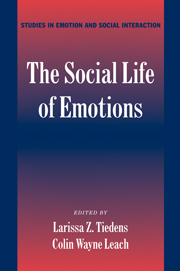Book contents
- Frontmatter
- Contents
- Acknowledgements
- List of Contributors
- The Social Life of Emotions
- Introduction: A World of Emotion
- PART I THE INTERPERSONAL CONTEXT
- PART II THE INTRAGROUP CONTEXT
- PART III THE INTERGROUP CONTEXT
- 11 Intergroup Emotions
- 12 Intergroup Contact and the Central Role of Affect in Intergroup Prejudice
- 13 Judgments of Deserving and the Emotional Consequences of Stigmatization
- 14 Group-based Emotions and Intergroup Behavior
- 15 Interpreting the Ingroup's Negative Actions Toward Another Group
- 16 Intergroup Schadenfreude
- Index
- References
11 - Intergroup Emotions
Emotion as an Intergroup Phenomenon
Published online by Cambridge University Press: 01 April 2011
- Frontmatter
- Contents
- Acknowledgements
- List of Contributors
- The Social Life of Emotions
- Introduction: A World of Emotion
- PART I THE INTERPERSONAL CONTEXT
- PART II THE INTRAGROUP CONTEXT
- PART III THE INTERGROUP CONTEXT
- 11 Intergroup Emotions
- 12 Intergroup Contact and the Central Role of Affect in Intergroup Prejudice
- 13 Judgments of Deserving and the Emotional Consequences of Stigmatization
- 14 Group-based Emotions and Intergroup Behavior
- 15 Interpreting the Ingroup's Negative Actions Toward Another Group
- 16 Intergroup Schadenfreude
- Index
- References
Summary
That emotions arise in intergroup contexts is of course uncontroversial. We are thrilled when our national team wins the World Cup against stiff competition, angry when protesters in another country burn our flag, excited as the party we voted for wins the election, and disgusted when local college students brawl drunkenly with a neighboring school. Despite the obvious impetus that intergroup behavior is to emotions, the idea that emotions may actually be intergroup phenomena is not so much controversial as it is, at least in social psychology, unconsidered. Emotion is typically assumed to be an individual phenomenon, triggered when an individual interprets events as either favoring or harming his or her personal goals or desires in the context of whether he or she has the personal resources to cope or not. Yet such approaches do not seem to fully capture the kinds of emotions evoked by our examples. Unless we are a member of the national team, caught by mistake in the demonstration, up for election, or one of those actually involved in the brawl, none of these events may impact us directly or personally. Yet because these events touch those we are close to, those we identity with, those we feel part of or one with, we, too, experience emotion.
Our attempts to explain such emotional experiences have led us to consider emotion as an intergroup phenomenon.
- Type
- Chapter
- Information
- The Social Life of Emotions , pp. 227 - 245Publisher: Cambridge University PressPrint publication year: 2004
References
- 65
- Cited by



